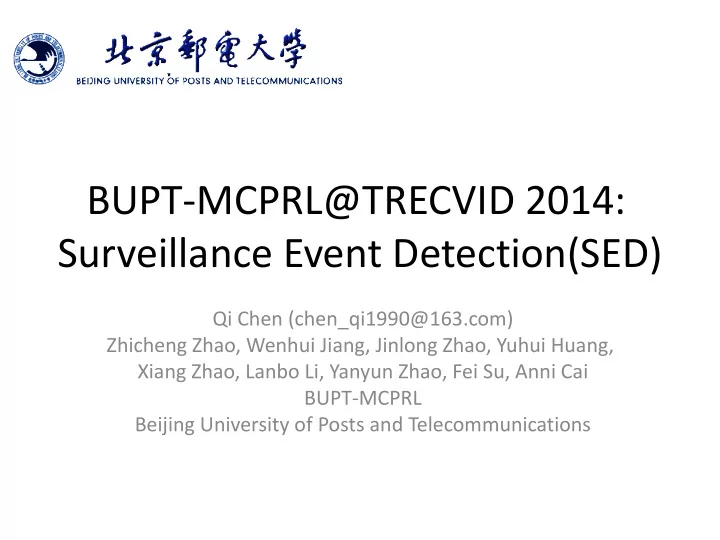

BUPT-MCPRL@TRECVID 2014: Surveillance Event Detection(SED) Qi Chen (chen_qi1990@163.com) Zhicheng Zhao, Wenhui Jiang, Jinlong Zhao, Yuhui Huang, Xiang Zhao, Lanbo Li, Yanyun Zhao, Fei Su, Anni Cai BUPT-MCPRL Beijing University of Posts and Telecommunications
Our Submission • BUPT_MCPRL 2014 Retrospective Result Event Rank ADCR ADCR of Other Best Systems Embrace 2 0.8318 0.8113 PeopleMeet 4 1.0354 0.8587 PeopleSplitUp 4 0.9476 0.8353 PersonRuns 4 0.9070 0.8256 Pointing 1 0.9998 1.0027
Outline • Retrospective System Overview • Pedestrian Detection • Pedestrian Tracking • Detected by CNN – Embrace and Pointing • Detected by Trajectory Analysis – PeopleMeet and PeopleSplitUp – PersonRuns • Performance Evaluation • Conclusion
Retrospective System Overview Embrace and Pointing Detection Events Classified Fusion by CNN Pedestrian Detections Detection by CNN PeopleMeet, PeopleSplitUp and PersonRuns Detection Pedestrian Trajectory Tracking Analysis
Pedestrian Detection • Pedestrian Detection by Head-Shoulder-CNN – suppress the effect of partial occlusion Training pos CNN Training CNN Model neg Detection Sliding Window
Pedestrian Detection • The Architecture of Our CNN – much smaller than Krizhevsky’s network [Krizhevsky, NIPS 2012] max max conv1 conv2 pool pool Image 5*5*64 5*5*64 2*2 2*2 stride 1 stride 1 stride 2 stride 2 max conv3 full4 pool full5 4*4*64 64 softmax 2*2 2 stride 1 dropout stride 2
Pedestrian Detection • Samples – from TrecVid08-Dev_set and TrecVid08-Eval_Set – positive • 11,538 for training • 4,946 for testing • randomly horizontal flipping – negative : • anything of non-positive • three times the number of positive • Details of Training – single NVIDIA GTX 780Ti GPU – Core i7 desktop CPU – 3 hours for training – learning rate : 0.01
Pedestrian Tracking • Multi-Target Tracking [Bo Yang et al. CVPR 2013] – online approach to learn non-linear motion patterns and robust appearance models – deal with detection result with long gap – more robust for tracking with lots of occlusion
Pedestrian Tracking • We Propose to use Gaussian process regression to smooth the trajectory. The relationship Pr(𝑥|𝑦) between Detection responses x Detection responses x and the the response x and point w of t true trajectory t Unsmoothed trajectories Smoothed trajectories
Outline • Retrospective System Overview • Pedestrian Detection • Pedestrian Tracking • Detected by CNN – Embrace and Pointing • Detected by Trajectory Analysis – PeopleMeet and PeopleSplitUp – PersonRuns • Performance Evaluation • Conclusion
Embrace and Pointing • Regard the events detection as the detection of key-poses • Key-poses for Embrace and Pointing Embrace Pointing
Embrace and Pointing • Method – adopt CNN to recognize the key-pose – use the architecture of pedestrian detection – the inputs of models are the pedestrian detection results with 1.5-fold expansion The architecture of our CNN
Embrace and Pointing • Samples – from TrecVid08-Dev_set and TrecVid08-Eval_Set – positive • total : 2100 • randomly cropping • randomly horizontal flipping • RGB jittering – negative • any pedestrian detection results of non-Embrace or non-Pointing • three times the number of positive • Details of Training – single NVIDIA GTX 780Ti GPU – Core i7 Desktop CPU – 2 hours for training – learning rate : 0.01
Embrace and Pointing • retro-Embrace Years ADCR MDCR #CorDet #FA #Miss 0.8318 0.8318 26 44 112 2014 2013 1.0503 0.9850 13 380 162 • retro-Pointing Years ADCR MDCR #CorDet #FA #Miss 0.9998 0.9910 21 57 774 2014 1.6387 1.0064 219 2576 844 2013
Outline • Retrospective System Overview • Pedestrian Detection • Pedestrian Tracking • Detected by CNN – Embrace and Pointing • Detected by Trajectory Analysis – PeopleMeet and PeopleSplitUp – PersonRuns • Performance Evaluation • Conclusion
PeopleMeet and PeopleSplitUp • PeopleMeet – split into 3 subevents: walking closely, slowing down and stay – use HMM ( Hidden Markov Model ) to model the event [Chan et al. ICPR 2004] – observe every two persons based on their trajectories – the distances between persons and their speed are used as features to construct observation sequence • PeopleSplitUp – split into 3 subevents : stay, speeding up, walking away – similar to the detection of PeopleMeet
PersonRuns • Distinguish running trajectories – pick the fast-moving pedestrian tracks by Forward- backward Motion History Image (MHI) [Z Yin et al. AVPI 2009] – FB-MHI = F-MHI & B-MHI – set a threshold of the ratio of non-zero pixels in the region of the pedestrian detection result Video Forward MHI Backward MHI Result
Performance Evaluation BUPT_MCPRL 2014 Retrospective Result (Update Version) ADCR of Other Event Rank Best Systems ADCR MDCR #CorDet #FA #Miss Embrace 2 0.8113 0.8318 0.8318 26 44 112 PeopleMeet 4 0.8587 1.0354 1.0018 6 128 250 PeopleSplitUp 4 0.8353 0.9476 0.9455 19 158 133 PersonRuns 4 0.8256 0.9070 0.9038 8 139 43 Pointing 1 1.0027 0.9998 0.9910 21 57 774 • Method of CNN • Embrace and Pointing • works very well • Method of Trajectory Analysis • PeopleMeet, PeopleSplitUp and PersonRuns • not good
Conclusion • We proposed the methods of CNN and trajectory analysis for event detection • Method of CNN – works very well – detects a small number of false alarms and a relatively big number of correct detections – much less computations – easy to implement • Method of trajectory analysis – not good – difficult to get the true information such as velocity
Thanks! www.bupt-mcprl.net
Recommend
More recommend